By Stephen Stirling
Two lifelong northern Queens residents are pushing a new vision for the long−abandoned Flushing Airport, and if they get their way, the future of the College Point site will be very green.
Historic Districts Council President and urban planner Paul Graziano and marine biologist James Cervino met with members of the city Economic Development Corp. last week to brief the agency on plans to identify a developer that would transform the 26 acres of developable property at Flushing Airport into a light recreation facility.
“We want to find someone that not only has a green thumb but has vision,” Cervino said. “We want something that empowers College Point, something that gives back to the community.”
Though it once served the majority of the air traffic in the city, Flushing Airport has remained vacant since it shut down in 1984. The site came close to being redeveloped in 2004, but plans pushed by Mayor Michael Bloomberg to move a 585,000−square−foot wholesale distribution center to the area were scuttled amid heavy community opposition.
Graziano and Cervino are hoping to find a developer who could put between $50 million and $75 million toward a recreation facility that could include baseball fields, a driving range, an education center and nature trails all designed within an environmentally sustainable framework.
“We see this as having the potential to be a model for green development,” Graziano said.
Cervino said the pair has been in talks with “a few” interested parties who would work closely with them to create something both profitable and that fits the needs of the community and local ecosystem.
“I don’t feel that this is ambitious. I think this is totally realistic,” Graziano said. “No question that private investor is out there. There just needs to be a good return.”
Graziano, who lives in Flushing, said the city needs to learn its past missteps at the highly valued but environmentally delicate site.
“I think that was a good lesson,” he said, speaking of the 2004 plan. “I think that the Bloomberg administration realized that they can’t propose something like this. You’ve got a situation where this isn’t just some piece of property. It’s a very environmentally sensitive property.”
“This is like a jungle,” said Cervino, a resident of College Point. “It’s a definite functioning ecosystem.”
Much of the 26−acre site owned by the city and eyed for development is surrounded by preserved wetlands, which have been marred by years of illegal dumping and pollution.
In its 2004 proposal, the city estimated cleanup of the site would cost upwards of $75 million. Cervino, however, said he believes the remediation of the area — which he said consists of hundreds of dumpsters filled with construction, auto debris and “hot spots” of pollutants — could cost less than a third of that amount.
“It has to be done right,” he said. “My biggest fear — is that this is not going to be cleaned up the right way.”
“Cervino added, “We can do it all, we just need to get the right person.”
Reach reporter Stephen Stirling by e−mail at sstirling@timesledger.com or by phone at 718−229−0300, Ext. 138.

































